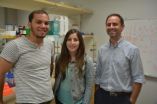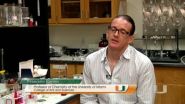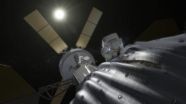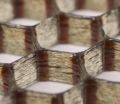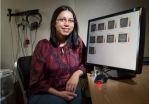(Press-News.org) COLLEGE STATION – Scientists with Texas A&M AgriLife Research have found a "Trojan horse" way to deliver proteins into live human cells without damaging them.
The finding, published in this month's Nature Methods, is expected to be easily adopted for use in medical research to find cures and treatments for a wide range of diseases, according to the team's lead scientist, Dr. Jean-Philippe Pellois, an associate professor of biochemistry at Texas A&M University.
"This is something that for many years people have tried to do, because proteins are basic components of the cell. They are the molecules that are doing all kinds of jobs inside the cell," Pellois said. "Being able to deliver a protein to change or study what the cell is doing is extremely useful."
Scientists with Texas A&M AgriLife Research have found a "Trojan horse" way to deliver proteins into live human cells without damaging them. Part of the team, shown here from the left, were graduate students Alfredo Erazo-Oliveras of Puerto Rico, Kristina Najjar of Lebanon and Dr. Jean-Philippe Pellois, Texas A&M University biochemist. (Texas A&M AgriLife Research photo by Kathleen Phillips)
Scientists with Texas A&M AgriLife Research have found a "Trojan horse" way to deliver proteins into live human cells without damaging them. Part of the team, shown here from the left, were graduate students Alfredo Erazo-Oliveras of Puerto Rico, Kristina Najjar of Lebanon and Dr. Jean-Philippe Pellois, Texas A&M University biochemist. (Texas A&M AgriLife Research photo by Kathleen Phillips)
Currently, scientists use different methods to try to figure out how molecules work inside a cell. In general, a scientist can deliver the DNA that codes for the protein into a cell, but that requires crossing the cell membrane, which damages or kills the cell, he explained. Also, the amount of protein produced by DNA expression is hard to control, and the DNA introduced can also alter the genome of cells in an uncontrollable and unpredictable manner.
"We bypass this and deliver the protein directly," Pellois said. "And the method we found delivers the protein very efficiently. A lot of the protein gets inside the cell, and we don't damage the membrane or alter the physiology of the cell.
"That's really powerful. It has an impact for cell biology, whether the question is how does the cell work and what do proteins do, or when a protein does not function properly, how does this lead to disease?"
Human cancer cells into which a protein with a green signal is delivered. (Texas A&M AgriLife Research photo courtesy of Dr. Jean-Philippe Pellois)
Human cancer cells into which a protein with a green signal was delivered. (Texas A&M AgriLife Research photo courtesy of Dr. Jean-Philippe Pellois)
He said the field of regenerative medicine could be one of the first practical applications because research there aims at reprogramming cells – for example,using a patient's skin cells reprogrammed asheart or liver cells to help that person recover from an illness.
"You can use those cells as therapeutic tools themselves that can repair damaged organs and tissues," Pellois said. "Our finding will allow these therapeutic challenges to be met by helping medical researchers get the reprogramming proteins inside cells safely."
Neuroblasts
Neuroblasts at a lower magnification. Red means a lot of protein was delivered. (Texas A&M AgriLife Research photo courtesy of Dr. Jean-Philippe Pellois)
Similarly, the method could be used in the battle against cancer, he added.
"A way to kill a cancer cell is to deliver a protein that is known to be a tumor suppressor," he said. "Sometime cancer arises when a certain set of key proteins called tumor suppressors stop functioning. When they function normally, they make sure that healthy cells don't start proliferating. But when there is a mutation in DNA that leads to a loss of function of those tumor suppressor proteins, that is when a cell can start going completely crazy and growing without limits.
"The idea is that if this protein can be reintroduced into the cancer cell – without damaging the cell — this protein might cause the death of the cancer cells. That would be a therapeutic tool using our method."
Drug development to treat specific ailments where a medicinal compound could be delivered into a cell is another potential use, he said.
His team derived the method from decades old knowledge of research on the HIV virus, which found a toxic protein that was able to go from one infected cell to an uninfected cell. Peptides derived from that protein have been studied for their ability to penetrate cells.
"Our contribution has been to take those compounds that work at very low efficiency and all of a sudden increase their efficiency dramatically. It took a clever guess and also luck to find the compounds that worked really, really well," he said of his team at Texas A&M which included Alfredo Erazo-Oliveras, Kristina Najjar, Laila Dayani, Ting-Yi Wang and Gregory Johnson.
He likened the discovery to "creating a Trojan horse for the cell."
"We are able to hijack the cell, and then use the cellchemistry to get those reagents to come out of what would be the equivalent of a Trojan horse," he said. "It is a little bit like kicking through the door. Usually, in kicking to get inside the cell the door is damaged.
"Because of that, it's a gamble. A lot of people were hesitant to make those reagents more effective because of the danger of what can happen to the cell. In other words, yes, you
may get in the cell, but if you destroy the membrane and kill the cell, what good is that?
"The surprise in our work is that despite being extremely efficient, despite presumably 'kicking through the door' and getting inside, the cell is okay," he said. "We don't quite know why, but what we suspect is that the cell is basically repairing the door as soon as it is broken. Perhaps the cell has a mechanism to repair itself, and we were lucky to stumble upon that to develop a technology that is both efficient and safe."
His team used "a library of cells" from people, chicken, monkeys and mice. There are slight differences, but more among different types of cells than by species. Some types — such as brain cells — are a bit more resistant, but the method still worked, he said.
"Now it is a question of fine tuning," Pellois said. "This delivery technology provides us a way to turn the cell into a test tube where we can add components, control how much we add and then look at what happens. That will allow us to study functions in mechanisms and in ways that have not been possible before."
INFORMATION:
Researchers discover 'Trojan Horse' method of penetrating cellular walls without harm
2014-06-26
ELSE PRESS RELEASES FROM THIS DATE:
Invasive watersnakes introduced to California may pose risk to native species
2014-06-26
Watersnakes, commonly seen in the lakes, rivers and streams of the eastern United States, are invading California waterways and may pose a threat to native and endangered species in the state, according to a University of California, Davis, study.
While scientists do not know exactly how many watersnakes are in California, roughly 300 individuals of two different species –the common watersnake and the southern watersnake -- have been found in the Sacramento area (Roseville and Folsom), and at least 150 were seen in Long Beach. Researchers suspect the nonvenomous snakes ...
Sequencing efforts miss DNA crucial to bacteria's disease causing power
2014-06-26
Genomic sequencing is supposed to reveal the entire genetic makeup of an organism. For infectious disease specialists, the technology can be used to analyze a disease-causing bacterium to determine how much harm it is capable of causing and whether or not it will be resistant to antibiotics. But new research at Rockefeller University suggests that current sequencing protocols overlook crucial bits of information: isolated pieces of DNA floating outside the bacterial chromosome, the core of a cell's genetic material.
"Extensive sequencing of chromosomal DNA has been performed ...
A win-win-win solution for biofuel, climate, and biodiversity
2014-06-25
Fossil fuel emissions release billions of tons of carbon into the atmosphere each year, which is changing the climate and threatening the sustainability of life on planet Earth. In Brazil, the demand for alternative energy sources has led to an increase in biofuel crops. A new "News and Views" paper in Nature Climate Change, co-authored by Woods Hole Research Center scientists Marcia Macedo and Eric Davidson, reviews new research conducted by Brazilian colleagues demonstrating the high carbon costs of converting intact Brazilian savanna compared to the carbon gains obtained ...
Scientists develop a 'nanosubmarine' that delivers complementary molecules inside cells
2014-06-25
VIDEO:
Francisco Raymo discusses his work in this video.
Click here for more information.
CORAL GABLES, Fla. (June 25, 2014) — With the continuing need for very small devices in therapeutic applications, there is a growing demand for the development of nanoparticles that can transport and deliver drugs to target cells in the human body.
Recently, researchers created nanoparticles that under the right conditions, self-assemble – trapping complementary guest molecules within ...
NASA's STEREO maps much larger solar atmosphere than previously observed
2014-06-25
Surrounding the sun is a vast atmosphere of solar particles, through which magnetic fields swarm, solar flares erupt, and gigantic columns of material rise, fall and jostle each other around. Now, using NASA's Solar Terrestrial Relations Observatory, scientists have found that this atmosphere, called the corona, is even larger than thought, extending out some 5 million miles above the sun's surface -- the equivalent of 12 solar radii. This information has implications for NASA's upcoming Solar Probe Plus mission, due to launch in 2018 and go closer to the sun than any man-made ...
New NASA model gives glimpse into the invisible world of electric asteroids
2014-06-25
Space may appear empty -- a soundless vacuum, but it's not an absolute void. It flows with electric activity that is not visible to our eyes. NASA is developing plans to send humans to an asteroid, and wants to know more about the electrical environment explorers will encounter there.
A solar wind blown from the surface of the sun at about a million miles per hour flows around all solar system objects, forming swirling eddies and vortices in its wake. Magnetic fields carried by the solar wind warp, twist, and snap as they slam into the magnetic fields around other objects ...
Carbon-fiber epoxy honeycombs mimic the material performance of balsa wood
2014-06-25
Cambridge, Mass. – June 25, 2014 – In wind farms across North America and Europe, sleek turbines equipped with state-of-the-art technology convert wind energy into electric power. But tucked inside the blades of these feats of modern engineering is a decidedly low-tech core material: balsa wood.
Like other manufactured products that use sandwich panel construction to achieve a combination of light weight and strength, turbine blades contain carefully arrayed strips of balsa wood from Ecuador, which provides 95 percent of the world's supply.
For centuries, the fast-growing ...
Changes in forage fish abundance alter Atlantic cod distribution, affect fishery success
2014-06-25
A shift in the prey available to Atlantic cod in the Gulf of Maine that began nearly a decade ago contributed to the controversy that surrounded the 2011 assessment for this stock. A recent study of how this occurred may help fishery managers, scientists, and the industry understand and resolve apparent conflicts between assessment results and the experiences of the fishing industry.
When the dominant prey species of Atlantic cod changed from Atlantic herring to sand lance beginning in 2006, cod began to concentrate in a small area on Stellwagen Bank where they were easily ...
New insights for coping with personality changes in acquired brain injury
2014-06-25
Amsterdam, NL, June 25, 2014 – Individuals with brain injury and their families often struggle to accept the associated personality changes. The behavior of individuals with acquired brain injury (ABI) is typically associated with problems such as aggression, agitation, non-compliance, and depression. Treatment goals often focus on changing the individual's behavior, frequently using consequence-based procedures or medication. In the current issue of NeuroRehabilitation leading researchers challenge this approach and recommend moving emphasis from dysfunction to competence. ...
People with tinnitus process emotions differently from their peers, researchers report
2014-06-25
CHAMPAIGN, Ill. — Patients with persistent ringing in the ears – a condition known as tinnitus – process emotions differently in the brain from those with normal hearing, researchers report in the journal Brain Research.
Tinnitus afflicts 50 million people in the United States, according to the American Tinnitus Association, and causes those with the condition to hear noises that aren't really there. These phantom sounds are not speech, but rather whooshing noises, train whistles, cricket noises or whines. Their severity often varies day to day.
University of Illinois ...
